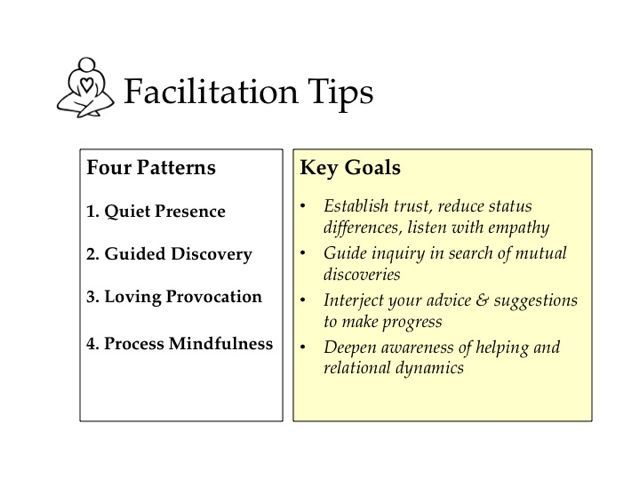![]() Helping Heuristics
Helping Heuristics
Practice Progressive Methods for Helping Others, Receiving Help and Asking for Help (15 min.)
You cannot help a man permanently by doing for them something they could and should do for themselves. – Abraham Lincoln
What is made possible? Participants can gain insight into their own pattern of interaction and habits. Helping Heuristics make it possible for them to experience how they can choose to change how they work with others by using a progression of practical methods. Heuristics are shortcuts that help people identify what is important when entering a new situation. They help them develop deeper insight into their own interaction patterns and make smarter decisions quickly. A series of short exchanges reveals heuristics or simple rules of thumb for productive helping. Try them out!
Five Structural Elements – Min Specs
1. Structuring Invitation
- Invite participants to view all human interactions as offers that are either accepted or blocked (e.g., Improv artists are trained to accept all offers)
- Ask them to act, react, or observe four patterns of interaction
- Invite them to reflect on their patterns as well as to consider shifting how they ask, offer, and receive help
2. How Space Is Arranged and Materials Needed
- Any number of participants, standing
- No tables in the way of people standing face-to-face!
3. How Participation Is Distributed
- Everyone has an equal opportunity to learn and to contribute
- Participants switch into one of three possible roles as the activity progresses
4. How Groups Are Configured
- Groups of 3: two participants interacting face-to-face in the roles of client and coach plus one observer
- Whole group for the debrief
5. Sequence of Steps and Time Allocation
- Explain that there will be four rounds of 1–2-minute improvised interactions. Groups choose one member to be a “client,” another a “coach,” with the third acting as “observer.” Roles can stay the same or change from round to round. The fourth round will be followed by 5 minutes of debrief. 2 min.
- During every round the person in the role of client shares a challenge he or she is passionate about. While the observer pays close attention, the coach responds in a sequence of patterns that is different for each round as follows.
- During the first round, the response pattern is “Quiet Presence”: the coach accepts all offers with compassionate listening [see the Liberating Structure Heard, Seen, Respected (HSR)]. 2 min.
- During the second round, the response pattern is “Guided Discovery”: the coach accepts all offers, guiding inquiry for mutual discoveries (see the Liberating Structure Appreciative Interview). 2 min.
- During the third round, the response pattern is “Loving Provocation”: the coach interjects advice, accepting and blocking as needed when the coach sees something that the client does not see (see the Liberating Structure Troika Consulting). 2 min.
- During the fourth round, the response pattern is “Process Mindfulness”: the coach and client accept all offers from each other, working at the top of their intelligence while noticing how novel possibilities are amplified. 2 min.
- Debrief the impact of all four helping patterns as experienced by clients, coaches, and observers. 5 min.
- Based on the debrief, repeat all rounds or only some for all participants to practice various response patterns.
WHY? Purposes
- Reduce/eliminate common errors and traps when people are giving or asking for help
- Change unwanted giving help patterns that include: premature solutions; unneeded advice; adding pressure to force use of advice; moving to next steps too quickly; trying too hard not to overhelp
- Change unwanted asking for help patterns that include: mistrusting; not sharing real problem; accepting help without ownership; looking for validation, not help; resenting not getting enough
Tips and Traps
- Encourage people to change roles in each round
- Develop trust, inquire humbly, create climate of mutual discovery
- Focus on patterns that will help the client finding his or her own solutions (self-discovery in a group)
- Do not ignore status differences, the setting, body language, demeanor, subtle signals
- The first cycle of four rounds can be used as preparation for deeper work on any single pattern
- After initial cycle, let trios choose the patterns they want to focus on in their group
Riffs and Variations
- Invite participants to create their own profile, self-identifying their default patterns and opportunities for growth
- Incorporate the helping progression into other Liberating Structures that focus on give-and-take: Troika Consulting, Wise Crowds, What I Need From You, Improv Prototyping, Simple Ethnography
- Start with “fun” patterns: neutral (zero response) and blocking by ignoring or interrupting
Examples
- Used when Wise Crowds or What I Need From You does not achieve a group’s intended purpose—for example, when participants have fallen into one of the unwanted asking for or giving help patterns
- For nurses, coaches, teachers, or anyone else in the helping professions to renew and learn new relational skills
- For any group working to improve interprofessional coordination
- For Liberating Structures facilitators to dig deeper into underlying patterns that cut across many Liberating Structures
- For expanding options when frustrated with trying to help another person
Attribution: Liberating Structure developed by Henri Lipmanowicz and Keith McCandless. Inspired by author/professor Edgar Schein (see Helping in Learning Resources).
Collateral Material
Below: Presentation materials we use to introduce Helping Heuristics

